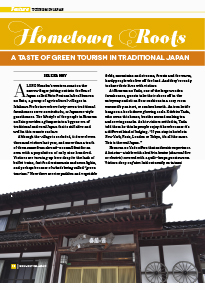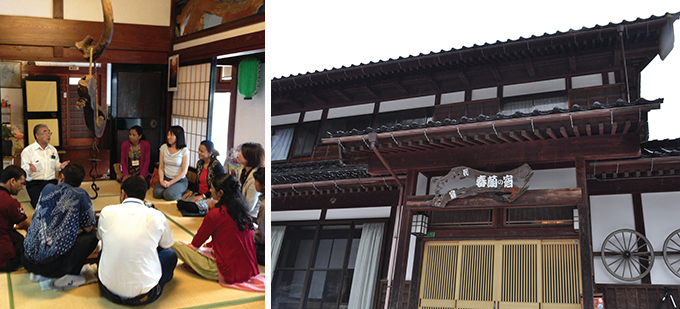Home > Highlighting JAPAN >Highlighting Japan April 2015>Tourism in Japan
Highlighting JAPAN

Tourism in Japan
Hometown Roots
A taste of green tourism in traditional Japan

Along Honshu’s western coast on the narrow finger jutting out into the Sea of Japan called Noto Peninsula lies Shunran no Sato, a group of agricultural villages in Ishikawa Prefecture where forty-seven traditional farmhouses serve as minshuku, or Japanese-style guesthouses. The lifestyle of the people in Shunran no Sato provides a glimpse into a bygone era of traditional and rural Japan that is still alive and well in this remote enclave.
Although the village is secluded, it drew eleven thousand visitors last year, and more than a tenth of them came from abroad—no small feat for an area with a population of only nine hundred. Visitors are turning up here despite the lack of bullet trains, fast food restaurants and neon lights, and perhaps because of what’s being called “green tourism.” Here there are rice paddies and vegetable fields, mountains and streams, forests and the warm, hardy people who live off the land. And they’re ready to share their lives with visitors.
At Shunran no Yado, one of the large wooden farmhouses, guests take their shoes off in the entryway and sit on floor cushions in a cozy room warmed by an irori, or sunken hearth. An iron kettle hangs on a hook above glowing coals. Kiichiro Tada, who owns this house, bustles around making tea and serving snacks. As his visitors settled in, Tada told them he thinks people enjoy it here because it’s a different kind of lodging. “If you stay in hotels in New York, Paris, London or Tokyo, it’s all the same. This is the real Japan.”
Shunran no Yado offers that authentic experience. A kotatsu—a table with a built-in heater (charcoal fire or electric) covered with a quilt—keeps guests warm. Visitors sleep on futon laid out neatly on tatami mats in another room. Back in the hearth room, a small kamidana (Shinto altar) is placed just below the rafters of the high ceilings for luck and good fortune.
“Eat your snacks!” Tada admonishes, putting a few pieces of locally produced coal on the fire.
“We only serve food taken from this area,” Tada notes. The meals are all homemade and largely vegetarian, using produce and rice grown in nearby fields, mushrooms and greens gleaned from the forest, and the occasional river fish caught in local streams. They don’t use any sugar or chemical additives, relying instead on time-honored methods to create tasty dishes like pickled daikon radish, ginger, umeboshi (salted plums) and fermented rice bran. “We’ve got things you can’t eat in the capital, that you can’t find in the supermarket,” Tada notes. “If you come here, you can get things found only here.”
Guests can also try their hand at gathering local delicacies themselves, in one of the many “experiences” Shunran no Yado offers. Activities include collecting akatake and nomero mushrooms in the fall, making mochi and miso or weaving brooms and slippers in the winter, picking mountain greens in the spring, and working in the fields in the summer to gather vegetables or cultivate rice. Food always seems to taste better when it’s been gathered and prepared by hand, especially when served on beautiful local lacquerware called wajima-nuri—a traditional craft well-known in Japan as the most prized lacquerware—as is the custom here.
And unlike at hotels and inns in the big city, guests here don’t simply eat their meals and then go back to their rooms and shut the door. Instead they linger by the irori, chatting with their hosts, swapping stories and songs, and learning about local history. Tada talks about the tanuki (wild raccoon dogs) that came to steal his kabocha squash left on the front porch. “But how do you know it’s a tanuki?” he’s asked. “Because!” he exclaims, “only a tanuki would steal a kabocha! You didn’t know that?”
Shunran no Sato may have no fast food restaurants or cinemas, but visitors will no doubt find plenty of ways to relax and fill their time here.
© 2009 Cabinet Office, Government of Japan






